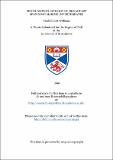Files in this item
Fertilization ecology of broadcast spawning marine invertebrates
Item metadata
| dc.contributor.advisor | Bentley, M. G. | |
| dc.contributor.author | Williams, Mark Elliott | |
| dc.coverage.spatial | 259 p. | en_US |
| dc.date.accessioned | 2018-06-25T13:43:35Z | |
| dc.date.available | 2018-06-25T13:43:35Z | |
| dc.date.issued | 1999 | |
| dc.identifier.uri | https://hdl.handle.net/10023/14544 | |
| dc.description.abstract | In situ measurements of the fertilization success of broadcast spawning marine invertebrates have been conducted mainly on shallow subtidal echinoderm and coral species. In this study, field fertilization success was measured for two infaunal, intertidal polychaetes Arenicola marina and Nereis virens. Both species are epidemic spawners, with populations of A. marina spawning over a few days in autumn while N. virens spawns in early spring. The fertilization success of female Arenicola marina is highly variable, ranging from 0 to 100%, and is determined by male spawning density. It is hypothesised that fertilization success over the entire spawning period is the result of an accumulation of fertilizations each day in the spawning period. Fertilization success was measured indirectly in Nereis virens by transplanting oocytes into the field. At least two spawning periods occurred for the population studied here. Fertilization success was uniformly high during the first period, and in the second fertilization success was highest among those eggs located high in the water column as opposed to those at substratum level. The fertilization strategies of these polychaetes are discussed in the light of these results. Comparative laboratory experiments were performed on factors that affect fertilization success in Arenicola marina. Nereis virens, Asterias rubens and Echinus esculentus, including sperm:egg ratio, sperm-egg contact time and sperm concentration. The extent to which each of these factors affects fertilization success varies with species, and this is explained by gamete attributes and mathematical models. Gamete longevity significantly affects fertilization success, and eggs and sperm of Arenicola marina are extraordinarily long lived compared to those of the other species studied here and elsewhere. Eggs are viable for 5 days after spawning, while dilute sperm remains capable of fertilizing eggs for more than 48 hours. The laboratory data are discussed in terms of the fertilization strategies of each of the species. | en_US |
| dc.language.iso | en | en_US |
| dc.publisher | University of St Andrews | |
| dc.subject.lcc | QL364.W5 | en |
| dc.subject.lcsh | Marine invertebrates | en |
| dc.title | Fertilization ecology of broadcast spawning marine invertebrates | en_US |
| dc.type | Thesis | en_US |
| dc.contributor.sponsor | Natural Environment Research Council (NERC) | en_US |
| dc.type.qualificationlevel | Doctoral | en_US |
| dc.type.qualificationname | PhD Doctor of Philosophy | en_US |
| dc.publisher.institution | The University of St Andrews | en_US |
This item appears in the following Collection(s)
Items in the St Andrews Research Repository are protected by copyright, with all rights reserved, unless otherwise indicated.

